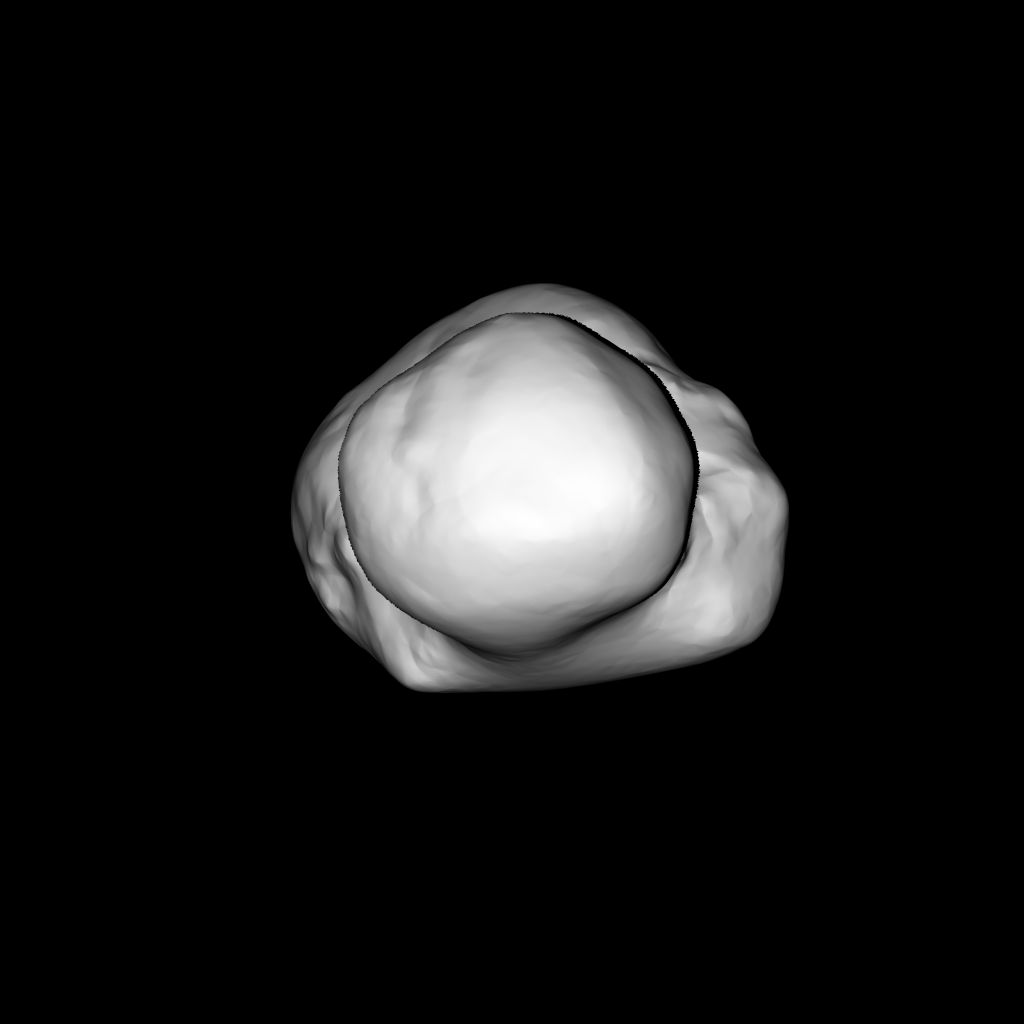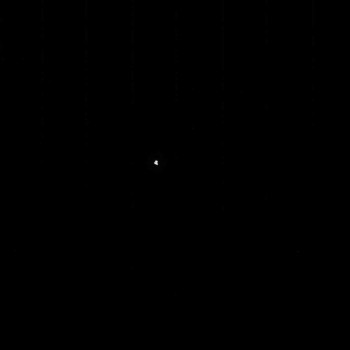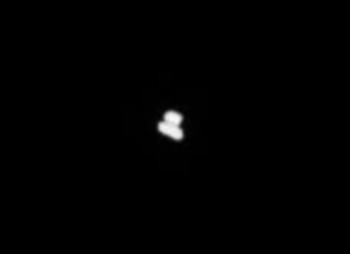In this week’s images, taken on 20 July from a distance of 5,500 km, comet 67P/Churyumov-Gerasimenko’s largest features are beginning to stand out in the OSIRIS narrow angle camera view.

Comet 67P/C-G on 20 July 2014 by OSIRIS NAC.
Credits: ESA/Rosetta/MPS for OSIRIS Team MPS/UPD/LAM/IAA/SSO/INTA/UPM/DASP/IDA
Each image in this sequence is separated by two hours, and the comet rotates with a period of approximately 12.4 hours. The binary nature of the comet can now be seen even images that haven’t been interpolated to smooth out the pixels, which overall has been likened to a duck in shape. The change in position of the dark strip across the ‘neck’ of the comet in the second and third images is a result of the change in illumination and the resulting shadows cast on the surface as the comet rotates.
One area of the neck seems significantly brighter than surrounding regions. This bright region, seen most clearly in the first image, may result from differences in surface composition or grain size. For example, could it be a region of freshly exposed ice or the product of resurfacing. Alternatively, it could be a topographical effect. The cause of this bright region will become clearer once higher-resolution images and spectral data are available.
The comet’s neck, that is, the join between the two segments of the comet nucleus, will hold important clues to the comet’s evolution history. Studying this region from close up, not just with images but also with other instruments to assess its composition, will help determine if the comet is a result of two separate bodies that are fused together, or if it is one object that has eroded in a dramatic fashion to produce the shape we see.

Shape model of comet based on 14 July images. Credits: ESA/Rosetta/MPS for OSIRIS Team MPS/UPD/LAM/IAA/SSO/INTA/UPM/DASP/IDA
Other features are also becoming apparent, although caution must still be exercised before drawing any robust scientific conclusions. But there is more reason this week to speculate that there might be a large depression – maybe an impact crater – on the smaller lobe of the comet (towards the bottom in the first image in the sequence). The images have a resolution of 100 metres per pixel, implying that this feature could be several hundred metres across. If it does indeed turn out to be an impact crater then its large size – along with composition information collected later – will help teach us about the comet’s interior properties, perhaps offering information on its strength and porosity.
Several other dark features seen on the body of the comet may also be shadows due to depressions, although at this distance it is not yet possible to conclude whether they are impact craters or the result, for example, of localised collapse caused by a weaker subsurface layer giving way – or something else completely!
Even though it is still difficult to discern individual features, it is possible to assess the comet’s shape. Indeed, from the images taken on 14 July, the OSIRIS team has begun modelling the comet’s three-dimensional shape. The animated gif presented here covers one full rotation of the nucleus around its spin axis, to emphasise the lobate structure of the comet. This model will be refined as more data becomes available – it is still a preliminary shape model and some features may be artefacts. Interestingly, the ‘crater’ discussed above, is not very clear at all in this early shape model, showing just how rapidly things are changing as we get closer.
The cadence at which OSIRIS is making observations of the comet is now increasing, focusing on different aspects of cometary science, and not just on the details of the nucleus. In general, some observations will focus on basic parameters of the comet, such as rotation rate and shape, and determining its mass and volume in order to establish its density, while others will provide wider-angle views of comet’s environment. Similarly, Rosetta’s other science instruments are also beginning to analyse the comet at a range of wavelengths to determine the comet’s temperature, gas and dust composition and production rates, nucleus composition and more. By 6 August, we expect to see high-resolution, close-up views of the comet surface.
In addition, Rosetta’s navigation camera, NAVCAM, is now imaging the comet daily for navigation purposes during the final approach. Therefore, presented here is the NAVCAM view from yesterday, 23 July, which also now shows the outline of the comet’s shape.
Shown here (above) is a full-frame (processed) view; the right hand frame presents a cropped, 10x zoom into the comet nucleus. NAVCAM has a 5-degree field of view and takes 1024 x 1024 12-bit per pixel images, so has lower resolution than the OSIRIS narrow angle camera.
The next OSIRIS image will be published a week today, on 31 July. Meanwhile, we plan to publish NAVCAM images on a daily basis during the spacecraft’s final approach to comet 67P/C-G.











Discussion: 29 comments
Hi! Please correct the typo: 31 July (I hope!) 😉
Thanks! Done…
What an EXCELLENT update. 🙂
Looks like the impaact crater I thought was visible on the Monday 14th July 214 images is real.
Quiet a few hills are visible as is a linear pepression on the ‘flatter’ lobe.
The shape model is interesting, but still leaving the question open as to whether or nor the two pieces are indeed two separate comets fused, or two pieces from the same paretn body or indeed a formerly more sheprical body ablating to that shape.
However I am not sure about the latter due to the short period of time that 67P/C-G being in this orbit with a closer perihelia.
Is it even possible to safely reduce the distance for the Philae landing to 1 km with such an irregular shaped rotating mass ? Just a thought, cheers…
Wouah ! Génial ! Vraiment étonnant ! Incroyable ! Superbe !
It’s incredible that after 10 years of travel we can get these pictures. The closer we get the more fascinating it becomes. This is really amazing !!!!! great job !!!!!! Looking forward for more 🙂
Great update, great science. Looking forward to hear more. Good luck team:)
Superb images and a very nice blog-update, thankyou. It’s wonderful to be allowed to accompany you on this final phase… very much appreciated.
Fingers-crossed that all goes well with the CAT burns and can’t wait for next-weeks image(s).
Go Rosetta, go Rosetta’s team and go Science!
At the moment it is looking rather like a human foetus! No more real of course than the “face” on Mars, I hasten to add.
Philae indeed looks like an incredible challenge, but it wouldn’t be our first giant leap.
I’m checking this site all the time and hoping!
Go Rosetta!
Great update, nice glimpse of the “neck”, can’t wait for the 6th of August to arrive even if these are my holidays and I don’t really want them to run out..
Thank you ; Rosetta ; for sending every day the navcam pictures; that is very great !!
Hi all,
Any possibility yet to guess where the big outburst from May came from ? That ought to have left a mark, if the surface was quiet since the last perihelion.
From that whiter area maybe? That seems the likeliest spot at the moment…
Good question! I think that is one we will have to ask the science teams during the 6 August arrival event.
Yes, thank you for giving us a daily update from the navcam, and congratulations to all for your remarkable achievements up to this point in the mission.
David
For over a month no images by either OSIRIS or the Navcam have been published that show any hint of a coma: do deeper images reveal some haze around the nucleus, or has C-G stopped all (visible) activity?
Hi Daniel, I understand analysis is ongoing in this area with respect to images. As I’m sure you know already, it is not just visual imaging that is important for studies of the coma/activity; other instruments are also studying this aspect at a range of wavelengths – for example, the water vapour detection by MIRO last month. According to the programme for 6 August event, we will have presentations by the PIs of OSIRIS, MIRO and VIRTIS, so we will hear more about these observations then.
wow its going good been looking forward to this for a long time!!!!!!
I wonder if Rosetta already passed through the coma released in April and early May, and if so if it was able to detect comet material in situ.
Because I have the possibility to use a 3D-Printer, it would be great if you could publish 3D-models (e.g. STL) as NASA did with the Homunculus Nebula: https://apod.nasa.gov/apod/ap140717.html
Yes!!! Please!
Great update! Now comes the most exciting phase of the mission! Good luck and thank you for the daily update of the Navcam-picture!
Where can I find these daily nav-cam photos?
PS. The Captchas are almost too difficult
for me. Please, find a better “gateway”.
Hi Ingo, They will be published here on the Rosetta blog, each day at around 15:00 CEST. They will also be publicised on other ESA social media channels, such as Facebook and Twitter.
Hi Emily, love the Navigation Camera release schedule.
The Navigation Camera is a lovely peice of kit in her own right. 1,024 by 1,024 pixels with five degree view, comet 67P/Churyumov-Gerasimenko is going to balloon in size very quickly, on a daily basis the comet will be appearing larger, fantastic. 😀
Hi Redgy,
It will be fine, the both the Rosetta Spacecraft and Philiae Lander are designed to operate in extremely close proximity to a rotating irregularly shaped body.
Please remeber that the gravity of Comet 67P/Churyumov-Gerasimenko, is extremely feeble, I cannot imagine it would be much above one part in one million of that on Earth.
The comet is only the size of a reasonably large mountain, but remember comet 67P/Churyumov-Gerasimenko is mostly ice with dust, and some of that ice may be loosely packed, there will be some harder, morew solid bits I would imagine, but the gravity is extremely weak.
Also the rotation is slow too. 12 Hours 36 minutes per rotation, slightly slower than the small hour hand on a clock face.
Rosetta and Philae will do fine, even only a few hundred metres from the surface, 1 KM is safe. Careful navigation will be required for sure, but the Rosetta team are more than competant. 🙂
Great! Thanks very much for the info.
I did lab research on hydrate ices and effect upon cometary nucleus in the late 1960’s under the wonderful guidance of Professor Armand Delsemme at Toledo University. Dr. Delsemme was then, and remains today, a world resource in comet research. He is in his 90’s now and his career has spanned an era wherein comets were an almost complete mystery to now when, with some luck, we may have a lander upon one. Wow!! It is my hope that Armand is enjoying these posts.
c’est passionnant. J’attends avec impatience les résultats (nature des roches : détection de quels minéraux sur chaque “lobe” et au niveau de la dépression). cela pourrait indiquer un corps parent différencié, ou effectivement 2 origines nettement distinctes ; on aura probablement bientôt des indices . BRAVO A TOUS CEUX QUI PARTICIPENT A CETTE MISSION
un traducteur automatique a transformé ma phrase de manière stupide, dommage !!!